Could you summarize what you do in the field for research?
My current research is focusing on integrating the field of One Health into my snow leopard work within western Mongolia. Partnering with Green Initiative NGO, Dr. Jan Janecka from Duquesne University, and an infectious disease physician, my new multi-disciplinary team is investigating the risk of diseases in snow leopards that can be transmitted through livestock, and can also infect herders.
In other projects in the past I’ve partnered with Irbis Mongolia Center, and the Mongolian Academy of Sciences to study snow leopards in areas of western Mongolia where there is very little to no data on their population. Signs of the cats, such as scat (which are analyzed for genetics), tracks, and scrapes are recorded, while camera traps are set to acquire images of individual cats. Another aspect of my research was to interview herders in order to gather information on livestock losses and determine attitudes towards snow leopards.
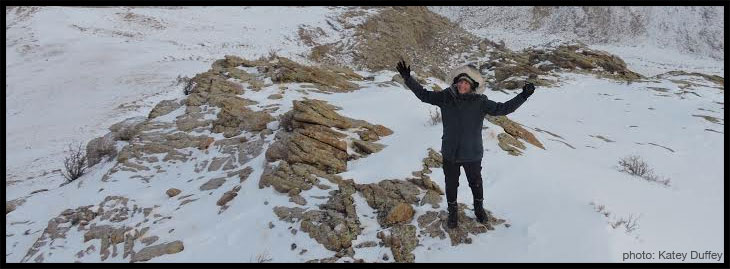
What does a typical field day look like?
The best time of year to study snow leopards is during the winter months. Snow makes finding tracks easier, it’s around breeding season for the cats, so they are more active, and conflicts with herder is higher because they settle their camps at the base of mountains where sleeping livestock become a buffet. However, winter is also the harshest season to endure. Average daytime temperatures can be anywhere between -20 – -35°C, while nighttime temperatures drop to -40° or even -50°. After waking up from my hoarfrost coated sleeping bag cocoon, my first thought is to get warm. I dawn more layers and start the fire in the stove. Days are short, so by the time the sun rises enough to provide light and warm the land a bit, it’s already close to noon.
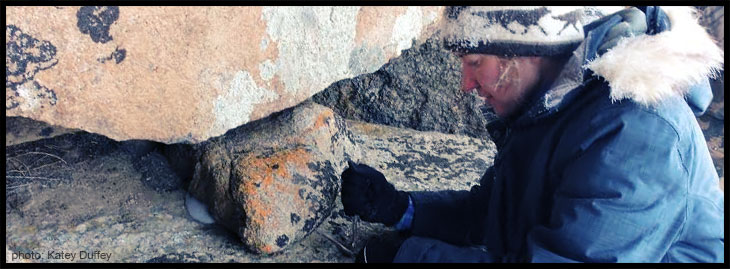
My teammate(s) and I then head to do a transect of a ridge-line we haven’t covered yet. Our objective is to find as much snow leopard sign as possible, while setting camera traps where we think would be the best spots based on the frequency of those signs. To get to the high altitude peaks where snow leopards reign, we have to hike up very steep slopes, scramble across snowmelt polished boulders, and climb up narrow, rocky ledges coated in snow and ice. In other words, we harness our “inner goat”. Once at the top we hike for several kilometers, scouting the ridges and outcrops before returning to camp as the sun begins its descent.
Back at camp, we make our one main meal of the day from boiled mutton, pasta, and potatoes, and prepare for the next day. Throughout the season we return to camera traps to check for images, and make sure that they are still working in the extreme cold. They will finally be collected at the end of the season, hopefully with some good snow leopard images among the hundreds of livestock selfies.
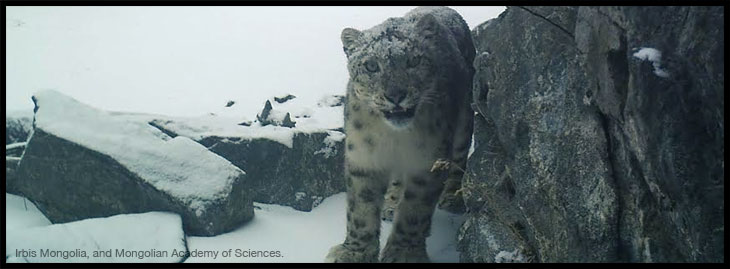
What inspired you to start doing this?
Growing up, I’ve always had a fascination with carnivores. I guess you could call it more of an obsession. I read dozens of books, and couldn’t get enough of watching documentaries. Their power and valuable role in an ecosystem drew me in. The fact that so many people around the world fear them, sealed my interest to help people further understand their nature.
Spending time hiking and exploring my local forests honed my passion for working in the wilderness. At some point I knew that studying some sort of carnivore in the wild was how I wanted to spend my life. I just couldn’t, and wouldn’t, imagine anything else.
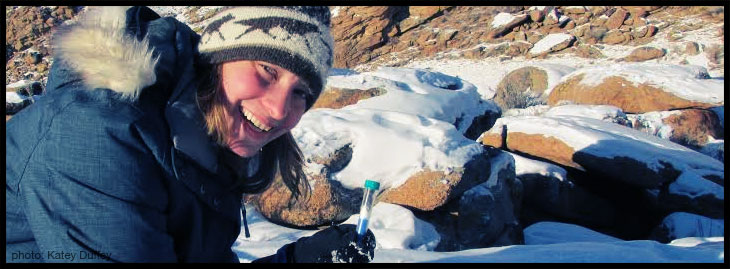
Why do you think it’s important – how does it benefit the animals?
Conducting population surveys is valuable to our understanding of how many of these elusive, Endangered cats are left in the wild, where they range, and how they use their habitat. Having knowledge on attitudes and perceptions of locals is crucial for conservation efforts to be implemented. Snow leopards threaten the livelihoods of herders when they kill livestock. Those herds are their bank account, and in Mongolia, herders receive no compensation. One of the most effective ways to protect snow leopards is to actually help herders protect livestock.
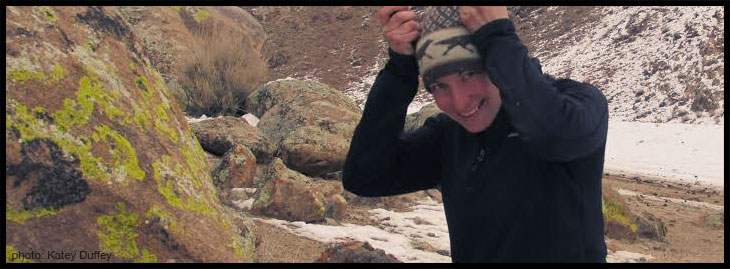
What is the hardest thing about doing this?
The most difficult part about doing fieldwork in Mongolia is actually interacting with locals. The culture is very different from that of “western cultures”. Many customs are a complete opposite from what I’ve been taught. However, the people are incredibly hospitable and more than happy to teach you.
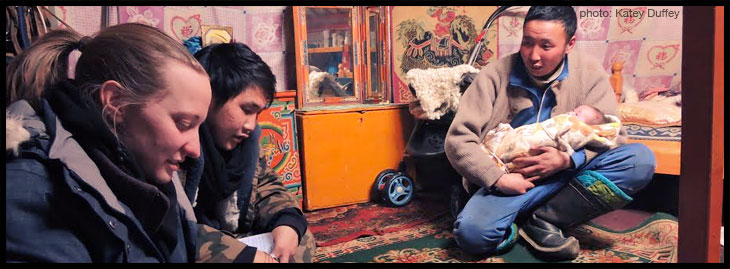
What is the most rewarding thing about it?
It feels good knowing I’m helping to add even a little bit more knowledge on such a mysterious predator, while working with locals to coexist with them.
What if others want to help but don’t want to go into the field. How can they help?
Others can help by spreading awareness about the status and threats to snow leopards. It’s important for people to not jump so quickly into criticizing locals for resorting to retaliatory killing, or even poaching, in order to survive. For poachers, one pelt can feed a family for months, and give them more than a year’s income! Spreading awareness will help educate the public on not only conservation issues, but will help stop the illegal demand for pelts and bones. People can also visit the websites of these organizations to learn more about various projects being done, that they can support:
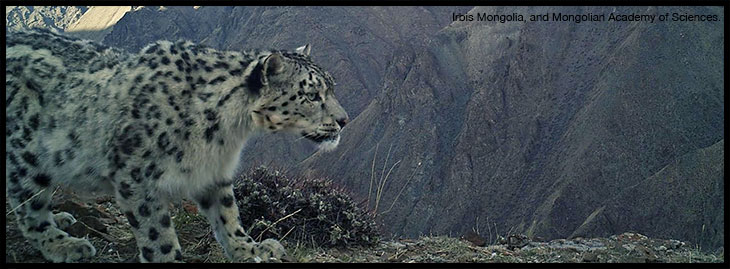
Finally, do you have any advice for a young student wanting to study something like this? What would you tell them?
This may sound a bit cliché, but Do. Not. Give. Up! I have personally run into countless closed doors, and have had many teachers and peers, tell me my career goals were impossible. There will be times where you may have to tweak your route toward what you want to study (such as working with different species in different habitats), or make an adjustment on what types of jobs you end up doing. This means you may have to take opportunities as they arise, even if at the time they don’t seem to have anything to do with your specific interest. Gain as much experience as you can with a variety of things, ask questions, learn to work with people with different interests, and become a sponge to learn all you can from those more “seasoned” than you. Your journey to follow your dreams may take longer for you than for others, and that’s ok. Ask yourself these questions: What do you want to do? Not what your family wants, or your friends, or your teachers, YOU! What is it that drives your passion? What are you willing to sacrifice to make it happen?
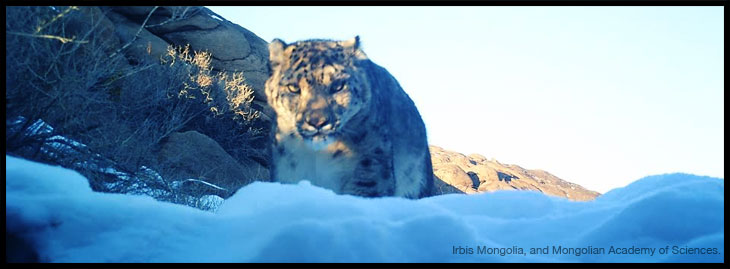
Don’t forget to read Katey’s new Snow Leopard article and her blog.
































































































